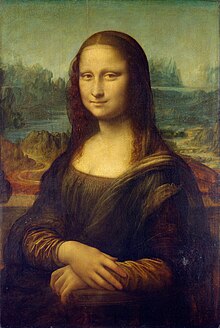
Back Ölmalerei ALS رسم زيتي Arabic Pintura al oleu AST Yağlı boya rəssamlığı Azerbaijani Алейны жывапіс Byelorussian Алейны жывапіс BE-X-OLD Маслена живопис Bulgarian তেলরঙ Bengali/Bangla Eoulliverezh Breton Pintura a l'oli Catalan
This article needs additional citations for verification. (September 2011) |

Oil painting is a painting method involving the procedure of painting with pigments combined with a drying oil as the binder. It has been the most common technique for artistic painting on canvas, wood panel or copper for several centuries. The advantages of oil for painting images include "greater flexibility, richer and denser color, the use of layers, and a wider range from light to dark".[1]
The oldest known oil paintings were created by Buddhist artists in Afghanistan, and date back to the 7th century AD.[2] Oil paint was later adopted by Europeans for painting statues and woodwork from at least the 12th century, but its common use for painted images began with Early Netherlandish painting in Northern Europe, and by the height of the Renaissance, oil painting techniques had almost completely replaced the use of egg tempera paints for panel paintings in most of Europe, though not for Orthodox icons or wall paintings, where tempera and fresco, respectively, remained the usual choice.
Commonly used drying oils include linseed oil, poppy seed oil, walnut oil, and safflower oil. The choice of oil imparts a range of properties to the paint, such as the amount of yellowing or drying time. The paint could be thinned with turpentine. Certain differences, depending on the oil, are also visible in the sheen of the paints. An artist might use several different oils in the same painting depending on specific pigments and effects desired. The paints themselves also develop a particular consistency depending on the medium. The oil may be boiled with a resin, such as pine resin or frankincense, to create a varnish to provide protection and texture. The paint itself can be molded into different textures depending on its plasticity.
- ^ Osborne (1970), p. 787
- ^ "World's oldest use of oil paint found in Afghanistan". World Archaeology. 6 July 2008. Retrieved 10 August 2020.